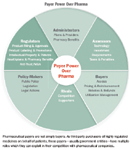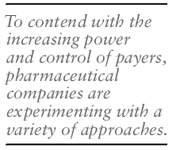The Payer C Change: From Customers to Competitors
"Payers have evolved to become powerful global contenders with pharma for increasingly limited funding of drug budgets."
Imagine the ultimate pharmaceutical competitor, one with the power to allow or deny drug approval and access; regulate and restrict indications, promotions, and utilization; demand rebates and force price cuts; ignore patents and transfer licenses; prevent corporate acquisitions and licensing deals; and support rival companies and products. This is not a pharma nightmare but rather an industry reality. Over the past 15 years, payers have evolved from their traditional role as one of the industry's three main customers to pharma's most formidable competitor.

Getty Images/RubberBall Productions
Payers are neither "direct competitors" like manufacturers of innovative or generic products nor "indirect competitors" like suppliers of substitute offerings like OTCs, supplements, medical devices, procedures, or technologies. Payers have become "budget competitors," an entirely new form of competition marked by conflict with pharmaceutical companies for an increasingly limited amount of funds and resources. Understanding why and how this payer shift to dominance occurred is critical for pharmaceutical professionals in adjusting their business model to manage threats and opportunities from this new landscape of supply and demand.
Four interdependent forces have transformed the pharma-payer relationship: the aging of the industry; novel information technologies; the multi-faceted roles of payers; and growing economic pressures. Over the last 15 years, the pharmaceutical industry has transitioned from the commercial stage to the competitive stage of its lifecycle. As in other mature industries, companies in this stage are selling to very experienced, sophisticated buyers who choose among numerous competing brands and generics or, in some cases, do not purchase at all. New information technologies enable these payers to capture and leverage extensive, real-world product data that is better than the companies' own research data. For example, the 15,000 physicians at Kaiser Permanente, the largest private payer-provider in the United States, obtain more drug usage information from Kaiser's integrated information systems than from pharmaceutical companies.

Payer Power Over Pharma
Unlike most other industries, pharmaceutical payers are not simply buyers. As third-party purchasers of highly regulated products on behalf of patients, these payers—usually government entities—have a myriad of roles which they can exploit in their pharma relationships (see Payer Power over Pharma chart). The combination of these three forces with the global recession and other pricing pressures, especially in European countries like Greece and Spain, has created a "perfect payer storm" for pharmaceutical companies. As a result, desperate but empowered payers are using the full range of their capabilities and controls to place more extreme demands on innovative pharmaceutical companies and products.
Swelling payer power has recently been demonstrated globally in a number of ways:
Pricing schemes. In June, the German government required pharmaceutical companies to provide a 16 percent rebate to public health insurers and instituted a price referencing system tied to low-pricing countries including Greece, which significantly depresses innovative drug prices. Separately, the Spanish government has enacted new measures that will require patients to pay the full price for 450 prescription medicines. According to the European Federation of Pharmaceutical Industries and Associations (EFPIA), price cuts and mandatory discounts levied by Greece, Ireland, Italy, Portugal, and Spain cost drug companies nearly $9 billion in 2010-11. After threatening to cease supplies of discounted drugs to Greece following additional government-mandated price reductions, CEO Gitte Aabo of Leo Pharma stated, "In my 18 years in the pharmaceutical industry, I have never experienced anything like these price cuts. It's much more severe than the impact of US healthcare reforms."
In China, the government announced plans in August to extend the number of products on its price-controlled Essential Drugs List from 307 to 700 by the end of 2012. In line with China's policy to reduce healthcare costs, this announcement signifies further price reductions on the more expensive drugs available from hospitals, which typically provide manufacturers with higher margins.
Generic utilization/substitution. India has enacted a $5.4 billion policy which provides free generic drugs to patients and requires doctors to select from a generics-only drug list or face punishment for prescribing prescription drugs. "The policy of the government is to promote greater and rational use of generic medicines that are of standard quality [and that] are much, much cheaper than the branded ones," stated India health official L.C. Goyal.
Prescription limitations. In the United States, 16 states have imposed monthly drug limits on Medicaid patients. For example, Mississippi and Illinois restrict coverage to two or four prescriptions drugs per month, respectively.
Coverage denial. The National Institute for Health and Clinical Excellence (NICE), the United Kingdom's primary health technology assessment group, has rejected reimbursement for nine of the last 10 end-of-life cancer drugs proposed by pharmaceutical companies, including Roche's melanoma treatment Zelboraf. Various forms of government agencies responsible for valuing and/or making nationwide coverage decisions on medical therapies have been established in: Canada, The Canadian Agency for Drugs and Technologies in Health Care or (CADTH); Germany, the Institute for Quality and Efficiency in Health Care (IQWiG); Australia, Pharmacy Benefits Advisory Committee (PBAC); and recently in the United States, the Patient-Centered Outcomes Research Institute (PCORI), which could evolve in that direction.
Competitor support. According to Decision Resources, the Russian government is implementing policies to help modernize and double the size of its domestic pharmaceutical industry by 2020. Russia wants to reduce drug prices and spending by 20 percent to 30 percent by substituting imported drugs with locally-produced medicines. The country is requiring foreign drug importers to invest millions of dollars in domestic manufacturing and to transfer knowledge and technology to local manufacturers as a quid pro quo for continued market access. In Brazil, the government has long supported local manufacturers by requiring global pharmaceutical companies to pay for product development and distribution and profit-share with local subsidiaries. This policy has resulted in sizable investments by global pharmaceutical players, such as Sanofi's acquisition of Medley Pharmaceuticals; GlaxoSmithKline's co-development deal with the government's parastatal firm Oswaldo Cruz Foundation; and Novartis's construction of a local manufacturing facility in the Brazilian state of Pernambuco.

Payer consolidation. US pharmacy benefit managers are rapidly consolidating to gain competitive advantages and negotiating leverage. Despite anti-competitive concerns, US Federal regulators in April approved the merger of two of the nation's three largest pharmacy benefit managers, Express Scripts and Medco Health Solutions, to form a $116 billion colossus. Together with CVS's recent acquisition of Caremark, these two merged entities now control nearly 75 percent of the pharmacy benefits market in the United States, creating tremendous leverage in negotiations with pharmaceutical companies.
Legal actions. In March, several health plans and Community Catalyst, a non-profit consumer advocacy group, filed class action lawsuits in four US courts against eight major drug manufacturers for illegally subsidizing co-payments for expensive brand-name prescription drugs such as Lipitor and Nexium through the promotion of co-pay coupons. In July, Walgreens, Kroger, Safeway, and other retailers sued Pfizer in US court for conspiring to delay the launch of generic Lipitor for two years and forcing the pharmacies to overpay for the world's best-selling cholesterol drug.
Patent challenges. In March, India forced Germany's Bayer to grant a compulsory license for the cancer drug Nexavar, which costs $5,700 for a month's supply. According to the Wall Street Journal, Indian patent regulators stated that local generic-drug maker Natco Pharma Ltd. had pledged to sell Nexavar for $178 a month.
Pharma's competitive responses
Reflecting on the multitude of recent payer challenges, GSK's CEO Andrew Witty announced at the annual EFPIA meeting in June that the pharmaceutical industry is "adapting to a new [payer] reality." To contend with the increasing power and control of payers, pharmaceutical companies are experimenting with a variety of approaches, which I refer to as the nine "C's" of pharma's competitive payer responses:
Cooperation. In 2010, Novartis announced plans to invest $500 million in Russia over five years, including construction of a manufacturing plant in St. Petersburg. Similarly, Teva, Novo Nordisk, and Nycomed are each investing $80-100 million to build local manufacturing and other facilities in Russia to try to satisfy the government's new manufacturing requirement.
Collaboration. In June, Novartis announced collaboration with the Malaysian Health Ministry to establish a $700 million fund to support new healthcare ventures to help enhance its stakeholder relationships and selling opportunities in Malaysia.
Cost-cutting. Roche is significantly cutting the price of MabThera (rituximab) and the breast cancer agent Herceptin (trastuzumab) in India and giving the cancer therapies new names. The company hopes to boost patient access and prevent a compulsory license transfer, resulting in potential generic competition. Roche spokesman Daniel Grotzky stated in a Wall Street Journal article that "there is the expectation that companies should do more to improve access to drugs. One instrument that has been used unilaterally by the Indian government was use of the compulsory license. We'd like to provide solutions to that, rather than be in a situation where you see unilateral action." Roche is also reducing the price of its non-Hodgkin's Lymphoma agent MabThera/Rituxan in Egypt and South Africa as part an overall emerging markets strategy in highly price-sensitive markets.
Contracting. In 2009, Merck and the US health-insurer Cigna signed a performance-based contract which provided higher discounts on Merck's diabetes agents Januvia and Janumet if Cigna's members achieved specified clinical outcomes and adherence measures. "Merck should be recognized as the first major pharmaceutical company to offer increased discounts on its oral anti-diabetic products, supporting Cigna's efforts to reduce A1C levels for individuals with diabetes, regardless of what medication they may be taking," said Eric Elliott, president of Cigna Pharmacy Management. "Improving people's health comes first for both Cigna and Merck. We hope this agreement will become a model in the industry." In 2010, GSK agreed to provide the United Kingdom's National Health Service a partial, retroactive rebate if the company's kidney cancer drug Votrient did not match up to Pfizer's rival Sutent in a head-to-head clinical trial to be completed in 2012. This special "guaranteed" pricing approach compelled NICE to recommend Votrient for NHS coverage.
Companion diagnostics. To help ensure US approval and reimbursement, Pfizer coupled its $100,000 per year cancer drug Xalkori with a companion diagnostic test from Abbott Laboratories to help physicians identify the 5 percent of patients whose non-small cell lung tumors expressed a specific ALK gene mutation. The goal is to ensure that the cost of the medicine is justified by targeting it only for those patients most likely to benefit. According to consulting firm PricewaterhouseCoopers, there were over 25 companion diagnostic deals in the United States in 2010 and 15 in the first half of 2011, up from only seven in 2008. A key question is whether drug inventors like Pfizer will have to continue to fund the cost of co-developing these diagnostics without any contribution from payers or patients.

Comparative effectiveness. In the past, pharmaceutical companies rarely conducted head-to-head trials against rival agents. However, with dramatically increasing competition for provider prescriptions and payer funding, many large pharmaceutical firms are conducting variations of "comparative effectiveness" studies, typically pitting their new medicine against other widely-used medications. Companies are also investing heavily in observational studies—real-world evidence—to protect their franchise against the growing tendency of payers to revise prices downward if exposure to the market suggests a medicine does not perform as expected in advancing therapeutic outcomes.
Criticism. Companies are using their global presence to pinpoint instances where payers may be denying access where others do not. In April, GSK executive Simon Jose publically criticized NICE stating that, "By denying access to benilumab [Benlysta], which is the first treatment specifically licensed and developed for lupus in over 50 years, UK patients are being left behind those in other countries, including the United States, Germany, and Spain who already have access to this medicine."
Challenges. Novartis is legally challenging the Indian government's refusal to grant a patent for its leukemia drug Gleevec, which has patent protection in over 40 countries, but which is facing a potential generic onslaught in India.
Confrontation. In Germany, Novartis recently pulled its anti-hypertensive Rasilamlo from the market three months after launch, while Lilly and partner Boehringer Ingelheim bypassed the German market for the launch of its diabetes drug Trajenta. Novo Nordisk refused to give in to price cuts in Greece and Spain by threatening to keep several new agents off the markets until both countries relented in later negotiations. In response to public criticism, Novo Nordisk CEO Lars Sorensen said, "I think actually it ought to be the [Greek] government who faces the patients and talks to the patients about why we cannot afford to buy the products that you have been used to getting because we didn't manage our finances well enough." Statements like these are controversial and represent just how seriously companies are taking the pressure from governments to serve as "lender of first resort" once public finances go bad.
Worldwide financial pressures will mount as national economies face low rates of GDP growth, mounting public debt, ageing populations, and the demands of growing middle classes in emerging markets seeking greater access to medicines. At the same time, pharmaceutical companies must work to maintain traditionally high margins on existing products to fund investment in higher-priced biologics. Consequently, the competition between pharmaceutical companies and payers—their long-standing customers—for funding will become dramatically more intense. Pharmaceutical professionals better get ready to handle the ultimate competitor.
Stan Bernard MD, MBA, is President of Bernard Associates, LLC, a global pharmaceutical industry competition consulting firm. He can be reached at SBernardMD@BernardAssociatesLLC.com.

The Misinformation Maze: Navigating Public Health in the Digital Age
March 11th 2025Jennifer Butler, chief commercial officer of Pleio, discusses misinformation's threat to public health, where patients are turning for trustworthy health information, the industry's pivot to peer-to-patient strategies to educate patients, and more.
Navigating Distrust: Pharma in the Age of Social Media
February 18th 2025Ian Baer, Founder and CEO of Sooth, discusses how the growing distrust in social media will impact industry marketing strategies and the relationships between pharmaceutical companies and the patients they aim to serve. He also explains dark social, how to combat misinformation, closing the trust gap, and more.